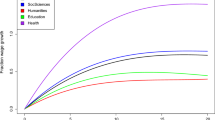Summary
In this paper we analyze the relations between university choice and earnings. We estimate a model in which a choice function determines the decision to apply to a particular university and thereby the switch to a particular wage regime. The wage structures of the options in turn determine the lifetime earnings prospects associated with those options, and these prospective earnings influence university choice. The results reveal some notable differences between the wage structures of graduates from different universities. In the choice function we find that graduates from different universities differ with respect to social background, gender and the motives that they consider important in choosing a department. A test on the possibility of pooling alternatives establishes heterogeneity of departments. Finally, we find that earnings prospects are not a particularly important factor in the choice of a specific university.
Similar content being viewed by others
References
Commissie Financieringsstructuur Onderzoek en Ontwikkeling, 1985,Rekenschap van creativiteit, The Hague.
Cramer, J.S., 1991,The LOGIT Model: An Introduction for Economists, London.
Cramer, J.S. and Geert Ridder, 1991, ‘Pooling States in the Multinominal Logit Model,’Journal of Econometrics, 47, pp. 267–272.
Freeman, Richard, 1986, ‘Demand for Education,’ in: Orley Ashenfelter and Richard Layard (eds.),Handbook of Labor Economics, Volume 1, Amsterdam.
Gaag, Jacques van der and Wim Vijverberg, 1988, ‘A Switching Regression Model for Wage Determinants in the Public and Private Sectors of a Developing Country,’Review of Economics and Statistics, 70, pp. 244–252.
Garen, John, 1984, ‘The Returns to Schooling: A Selectivity Bias Approach with a Continuous Choice Variable,’Econometrica, 52, pp. 1199–1218.
Hartog, Joop, Gerard Pfann and Geert Ridder, 1989, ‘(Non-)graduation and the Earnings Function: An Inquiry on Self-selection,’European Economic Review, 33, pp. 1373–1395.
Kenny, Lawrence, Lung-Fei Lee, G.S., Maddala and Robert Trost, 1979, ‘Return to College Education: An Investigation of Self-selection Bias Based on the Project Talent Data,’International Economic Review, 20, pp. 775–789.
Kodde, David and M.A.M. Theunissen, 1985,De schoolloopbaan van snelle vwo-leerlingen, sexeongelijkheid en de keuze voor hoger onderwijs, Ministerie van Onderwijs en Wetenschappen, The Hague.
Lee, Lung-Fei, 1978, ‘Unionism and Wage Rates: A Simultaneous Equations Model with Qualitative and Limited Dependent Variables,’International Economic Review, 19, pp. 415–433.
Lee, Lung-Fei, 1983, ‘Generalized Econometric Models with Selectivity,’Econometrica, 51, pp. 507–512.
Manski, Charles and David Wise, 1983,College Choice in America, Cambridge Mass.
McFadden, Daniel, 1974, ‘Conditional Logit Analysis of Qualitative Choice Behavior,’ in: P. Zarembka (ed.),Frontiers in Econometrics, New York.
Mincer, Jacob, 1974,Schooling, Experience, and Earning, NBER, New York.
Micklewright, John, 1989, ‘Choice at Sixteen,’Economica, 56, pp. 25–39.
Oosterbeek, Hessel, 1990, ‘Education and Earnings in the Netherlands; An Empirical Analysis,’European Economic Review, 34, pp. 1353–1375.
Oosterbeek, Hessel, Joop Hartog and Joop Odink, 1990, ‘Wage Differentials between the Public and Private Sectors: An Application to Dutch Economists,’ Mimeo, University of Amsterdam, Faculty of Economics and Econometrics.
Rosen, Sherwin, 1977, ‘Human Capital: Relations between Education and Earnings,’ in: M. Intriligator (ed.),Frontiers in Quantitative Economics, Amsterdam.
Stewart, Mark, 1987, ‘Collective Bargaining Arrangements, Closed Shops and Relative Pay,’Economic Journal, 97, pp. 140–156.
Trost, Robert and Lung-Fei Lee, 1984, ‘Technical Training and Earnings: A Polychotomous Choice Model with Selectivity,’Review of Economics and Statistics, 66, pp. 151–156.
Willis, Robert, 1986, ‘Wage Determinants: A Survey and Reinterpretation of Human Capital Earnings Function,’ in: Orley Ashenfelter and Richard Layard (eds.),Handbook of Labor Economics, Amsterdam.
Willis, Robert and Sherwin Rosen, 1979, ‘Education and Self-selection,’Journal of Political Economy, 87, pp. S7-S36.
Author information
Authors and Affiliations
Rights and permissions
About this article
Cite this article
Oosterbeek, H., Groot, W. & Hartog, J. An empirical analysis of university choice and earnings. De Economist 140, 293–309 (1992). https://doi.org/10.1007/BF01799322
Issue Date:
DOI: https://doi.org/10.1007/BF01799322




